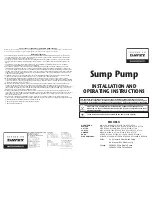
11
direct water spray.
4.3. At the bottom of the suction pipe must
be fitted with non-return valve. Without it is
impossible altogether (bleeding) and water.
4.4. Install the inlet pipe so that a constant
slope from the pump to the water source. In no
case should allow part of the intake manifold is
of greater height than the pump because of the
possibility of the emergence of “hovercraft”.
4.5. In the presence of sand in the water must
be installed filter.
4.6. Before you join, and the pump inlet pipe
should be filled with water. Before putting into
operation each pump must be filled with water
to a force-pipe nozzle, to be able to suck away.
Rotation of the pump without water, repeatedly
cutting her life.
4.7. In case of damage due to operation of the
pump dry, the security lapse.
4.8. Filling the pump with water (bleeding).
Open for pouring stopper (4) and pour water
while pumping chamber is not filled. Must merge
enough water to fill the entire intake manifold
and the turbine chamber to the pump. If despite
your efforts pumping chamber is not filled, this
means that non-return valve (1) mounted at the
bottom of the inlet pipe is not in working order
and must be replaced.
4.9. After filling the pump with water
dispensers Screw stopper (4).
4.10. To be perfect is an important force-
suction tube is mounted in a vertical position for
at least 50 centimeters before placing the knee.
If using a flexible tube (similar to garden hose)
at the place suction hose in a vertical position at
least 70 cm (see diagram A).
4.11. All joints and connections on suction
and Injection piping must be firm, precise and
tight checked for leaks. Check carefully the
connection of pipes to pump. Poor associated
piping can lead to falling of air into the system,
which can disrupt proper operation of the pump.
5. Turn the pump. Insert the plug of the power
cord into the outlet. Do not let the pump operate
in a closed floodgate of Injection piping. Open all
interlocks, are in force-pipeline (valves, valves,
etc.).. Turn the pump through the switch. After
use, turn off the pump through the switch.
6. Support and maintenance. Before starting
maintenance work and maintenance, the pump
should be excluded from the network. Pull the
plug of the power cord from the outlet.
6.1. Wash the pump. After working with pools
of water containing chlorine or liquid, leaving
sediment, the pump must be washed with clean
water.
6.2. Removal of blockages. Remove suction
tube from the pump inlet. Connect the hose
to the conduit through the body and allow the
pump to run water until you remove the pollution.
Before re-commissioning of the pump can check
whether it is idling through a short integration.
6.3. Frost protection. Protect pump from
freezing. To this end, unscrew the stopper for
the drain (5) at the bottom of the pump nozzle
into a suction tube. At very low temperatures,
removing the pump and store in a safe place.
6.4. You should always vent to the motor free.
6.5. If necessary, repair your pumps and power
is best carried out only by qualified specialists
in workshops RAIDER, which used only original
spare parts. Thus ensuring their safe operation.
7. Environmental protection.
In order to protect the environment electrical
machinery, appliances and additional packages
must be subjected to appropriate processing
for reuse of the information contained in these
materials.
Do not dispose of electrical equipment in
domestic waste! Under the EU Directive 2002/96/
EG on scrapped electrical and electronic
equipment and promoting law and national
electrical machines, which can be used more,
must be collected separately and be subjected
to appropriate processing for recovery of the
information contained in these secondary
materials.












































